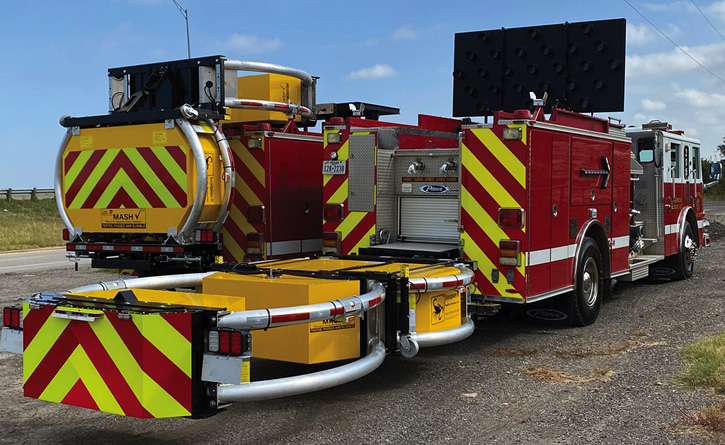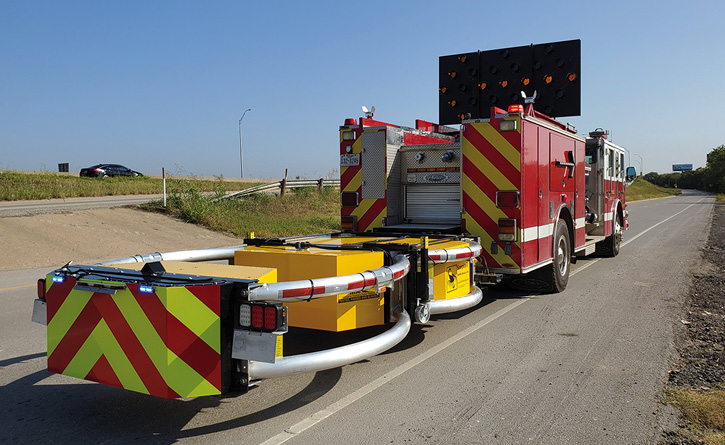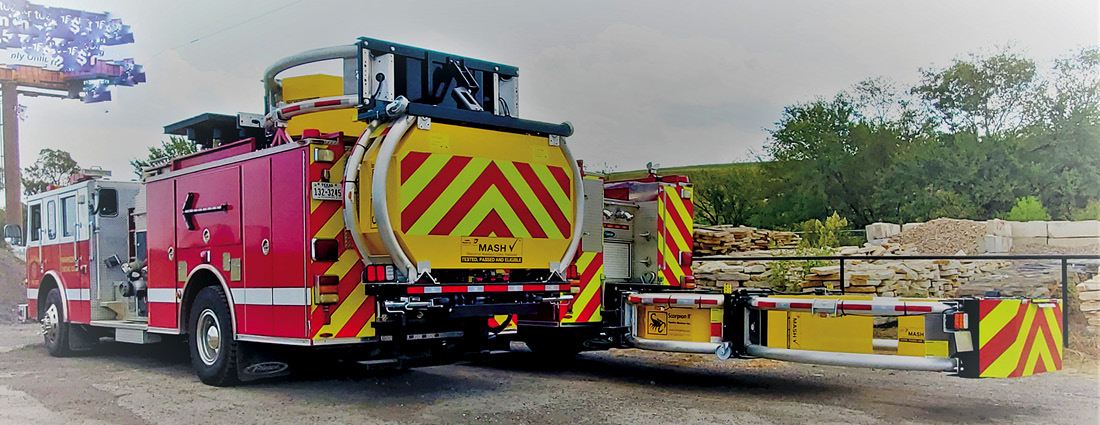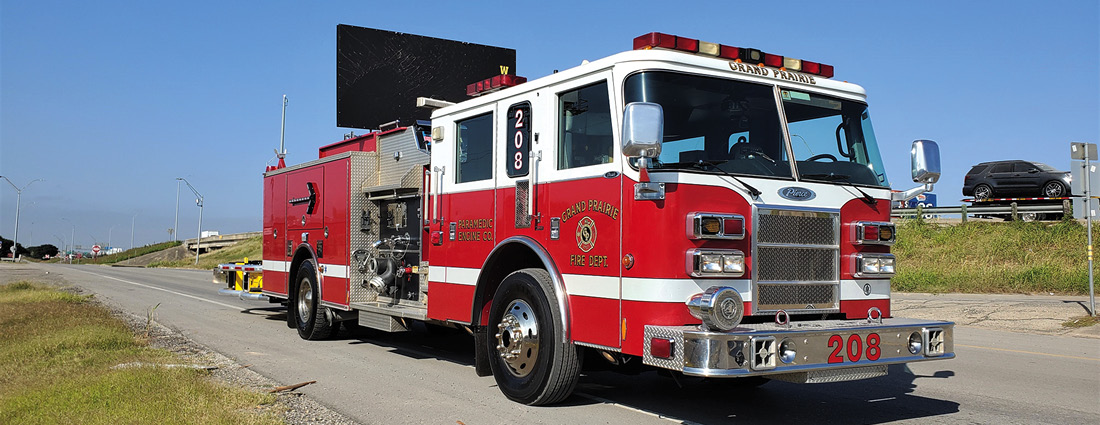
Grand Prairie (TX) Fire Department Captain John Stevenson knew there had to be a better way to protect firefighters and responders at crash scenes on highways that crisscross his Texas city in the Dallas/Fort Worth metro area.
So, the department outfitted two reserve apparatus with traffic management attenuators (TMAs)—sacrificial mobile crash cushions attached to the rear of the apparatus frames. It’s thought to be the first time fire departments have equipped fire apparatus with such devices.
JUSTIFICATION
Several of the department’s front-line vehicles had been hit, including a $1.1 million aerial that was out of service for about a year, having been sent back to the manufacturer for repair. “And, it was never right after that,” Stevenson laments. “That was a $1.1 million apparatus gone. We don’t have other reserve aerial apparatus, so our citizens lost that resource.”
RELATED
Keeping It Safe: Blocking Apparatus and Conspicuity
Irving (TX) Fire Department Gives New Life to Old Apparatus As Highway Blocking Vehicles
Implementing An Blocking Engine Program
Stevenson says his chief, Robert Fite, tasked him with coming up with a solution to the growing problem in the department. It was a problem that claimed the lives of 16 firefighters nationwide in 2019.
The Irving (TX) Fire Department, a neighboring department under the guidance of Chief Victor Conley, was a pioneer in his area, according to Stevenson, taking a reserve apparatus, putting a few more lights on it and other modifications, and calling it a blocking apparatus. “The city of Irving had several highway incidents in a row, and Chief Conley said, ‘Enough is enough,’ ” Stevenson says. “They had their front-line apparatus taken out time and time again.” He adds Conley “really sparked” the blocking program in the area, and Grand Prairie expanded on it with traffic attenuators.

1 The Grand Prairie (TX) Fire Department has two apparatus in service fitted with TMAs. The devices, typically installed on highway construction and road crew vehicles, are designed to absorb energy from a vehicle impact and deflect the wayward motorist away from responders who may be in the road. (Photos courtesy of Gulf Highway Equipment.)

2 The TMAs mounted on Grand Prairie’s blocking apparatus are able to handle an impact of a vehicle traveling at speeds up to 62.5 mph, absorbing the energy while protecting the passengers in the striking vehicle and the responders who may be working in front of the blocking vehicle.
Grand Prairie had two 2003 front-line pumpers that were being pushed back to reserve. “We had a blocking policy with aerial apparatus, using them on highways and our high-speed corridors to block the scene to protect firefighters,” Stevenson says.
A NEW SOLUTION
Enter Travis McCain, owner of Gulf Highway Equipment, Haltom City, Texas. McCain’s company is a truck upfitter, founded in 2014, that specializes in installing TMAs on a variety of vehicles for highway road crews and others who work on roadways. McCain says that back in 2015 he did some sketches and drawings of a fire truck with a TMA installed. “It’s just kind of a grassroots effort,” McCain says. “Everyone we talk to is like, ‘OK, that’s a great idea, but how do we do it?’ ”
McCain says Grand Prairie fire officials reached out to see if it was possible to have TMAs installed on a couple of trucks for their department, and the project was launched. “We did a little better renderings and drawings and did some computer animation, and they got excited and said, ‘Yeah, let’s do it,’ ” McCain says.
CONFIGURING THE RIGS
The TMA installation cost between $40,000 and $50,000, according to McCain. He notes that the price depends on the options, arrow board, and lights departments choose. It’s a good investment, he says, considering the cost of an apparatus and the incalculable cost of a life.
Grand Prairie was able to use a reimbursable grant administered through the Texas Department of Transportation to cover the cost of the TMAs, Stevenson says. With eight major highways with 75-mile-per-hour (mph) speed limits, safety and security on the scene are very important for responders, he adds. “These TMA units will exponentially increase our protection out there,” Stevenson says. “And by protecting ourselves, we protect the citizens. It’s a game changer for use on the highways.”
Stevenson adds that Grand Prairie’s blocking policy was “kind of a Band-Aid®,” simply strategically placing apparatus in a manner to create a safe zone. Blocking using in-service apparatus not only put the truck assets at risk for damage, but it also put the motoring public at risk, Stevenson says. Hitting a solid object, like a fire apparatus, at a high rate of speed can mean serious injury and even death for those in the vehicle hitting the fire truck, Stevenson adds. “I didn’t like the idea of sticking an apparatus out there knowing they were going to be hit by a motorist,” Stevenson says. “There is no type of certified protection on it. That’s something that really struck me.”
Stevenson says he noticed highway departments, road crews, and maintenance personnel had special attenuator devices on their trucks for scene safety. “They don’t just stick trucks out there,” says Stevenson. “They have special attenuator devices on them to absorb the kinetic energy of an impact that protects the driver.”

3 TMAs manufactured by TrafFix Devices, Inc. have been installed by Gulf Highway Equipment on two reserve engines in the Grand Prairie Fire Department fleet. The attenuators are powered by hydraulic-over-electric motors and cylinders. The devices fold flat against the back of the apparatus and nest into the hosebed area.

4 The blocking apparatus started out as front-line engines. The apparatus, originally built in 2003, will continue to serve the department in a reserve capacity with water in the 500-gallon tanks, functioning pumps, and tools. To accommodate the traffic management attenuators, the large-diameter hose in the hosebed had to be removed. The apparatus still has functioning crosslays and preconnected lines.
Stevenson says that whether a driver is on a cell phone, driving while intoxicated, or distracted for whatever reason, firefighters work to protect citizens. “We still want to protect citizens no matter what,” Stevenson states.
In doing some research, Stevenson found the TMAs built by TrafFix Devices, Inc., San Clemente, California, were widely used by construction and roadway crews throughout the nation. “That’s the main product out there,” he says. “They are built for lateral loads and inline loads to reduce the kinetic energy, and they have been certified by the DOT and the National Highway Transportation Association for those impact tests.”
Stevenson says people were dying after hitting apparatus with no TMAs. “It was killing them,” he asserts. “I don’t want a crew out there with that on their conscience. By putting these attenuators out there, it does a couple of things. One, it gives us a little more safety and security and two, it protects the apparatus. If you just put the apparatus out there, and it gets struck, you’ve got only one shot at it. It’s gone. The attenuator is mounted with six bolts and three plugs. We can take off the damaged attenuator and put another one on. It’s out of service for only a few hours. It’s a real short downtime.”
It doesn’t take a long time for the initial installation, either, McCain says, explaining it takes about three to four weeks from start to finish to do the job from frame modifications to application of chevrons and delivery.
Stevenson says the attenuators make it much safer for passengers too if a crash occurs, and it gives the apparatus additional length to block as many as four lanes.
THE ATTENUATORS
Jim Marshall, vice president of marketing for TrafFix Devices, Inc., says the company has been making traffic attenuators for around 20 years, and its brand name for the device is the Scorpion. “It’s a product that was invented and patented by TrafFix Devices,” Marshall says. “We have, over the years, provided these around the world to companies that primarily use them in traditional construction work zones on municipal highways.”
Marshall explains that the product is designed to provide a barrier for workers and responders in the roadway while minimizing harm to motorists if they hit one of the TMAs. “Our unit is tested through what is called the Manual for Assessment of Safety Hardware (MASH),” Marshall says. “MASH is a test standard that all people who manufacture these kinds of products have to meet.” He added that the TrafFix Devices products are sold all over the world.
The Scorpion products attached to the Grand Prairie apparatus are tested at MASH Level 3, the highest, Marshall says, noting that means the TMA can handle an impact of 62.5 mph at different angles with two different weight vehicles: a smaller, compact car, for instance, and a larger quad cab pickup. “The tests are designed to mimic the U.S. fleet—the vehicles that are out on the road in America,” Marshall says. He adds that the Scorpion “performs tremendously” at even higher speeds and heavier vehicles. He says the driver of a semi-truck traveling at 70 mph can hit one of the TMAs and walk away from the crash, and all the workers are protected.
TrafFix Devices also has another product called the Scorpion Metro, which is shorter and can withstand impacts at 50 mph, Marshall says, adding that it’s a perfect product for a department responding to areas with municipal speed limits that don’t see the high speeds experienced on eight-lane superhighways. Grand Prairie chose the full Scorpion product because of the number of high-speed motorways it has in the area, Stevenson says. “It’s like a raceway out there.”
First responders are logical buyers of this kind of product, Marshall says, but they have been slow to adopt the concept. “Their adoption of this kind of product has been very slow because they have created a response that utilizes million dollar engines and million dollar ladder trucks as blocking mechanisms to protect lifesaving going on at the incident.”

5 As blocking vehicles, Grand Prairie’s TMA apparatus have extra warning lights, arrow board, LED signs, and LED traffic directional arrows on each side of the vehicles.
Marshall says he’s been attending trade shows, like FDIC International, in an attempt to get fire departments to change their tactics. He says he’s learned that many fire departments are spending more time on highways with crashes and incidents than they are fighting structure fires. “Firefighters are becoming injured more and more due to activities on roadways,” he says. “So, the portable crash unit like the Scorpion is truly in the best-practices category for saving and protecting workers on the roadways, and firefighters fit into that category when they are responding to crashes on public roads.”
While it may be a best practice, a TMA on a fire apparatus “is a fairly inexpensive spend when you look at what you are protecting,” Marshall says. “You are not only protecting the lives of firefighters, but also most vehicles, which are very expensive. Our Scorpion attenuator will take the impact; attenuate the energy; and, in most cases, the host vehicle can go with no damage or minimal damage in a crash. It makes perfect sense.”
FIRE APPARATUS APPLICATION
While TrafFix Devices has perfected the TMA, McCain has perfected the installation of the devices on trucks, particularly fire apparatus.
John Gense, southwest regional sales manager for TrafFix Devices, Inc., says McCain, through Gulf Highway Equipment, has received extensive training on the installation and repair of the TrafFix Devices Scorpion. “To say he is the leader of the certified attenuator program in the state of Texas would be an understatement,” Gense says. “His extensive knowledge of our Scorpion TMA was really a benefit with this install, as well as other fire trucks he’ll be doing installs on.”
For now, Gulf Highway Equipment is the only company authorized to install TMAs on fire apparatus. While the installations are not difficult, fire trucks are more complicated and sophisticated than a highway road crew construction vehicle, McCain says. He adds that fire apparatus with TMAs need additional warning lights and, in the case of Grand Prairie’s apparatus, traffic directional signs were added to the tops of the apparatus as well as a hopper for absorbent material used at crash scenes.
Stevenson, point man for the TMA apparatus, says the hopper holds nine cubic feet of material in the area where the deck gun was previously located. “We always ran out of absorbent on those highway incidents,” he says. “Now, we can walk up to either side of the apparatus with a five-gallon bucket and fill it up.” Stevenson said that was perhaps the biggest modification done to the apparatus.
STILL FIRE APPARATUS
The two TMA-equipped units will continue to be in service as fire apparatus, just with a special assignment. They will still carry water and have operational pumps and some hose as well. The beds for 5-inch hose on the backs and tops were modified so the TMAs will fold down, so the 1,000 feet of large-diameter hose was eliminated, Stevenson says. “That doesn’t mean we couldn’t put a few sections of 5-inch hose in compartments or even on top,” he adds. “It’s just that we can’t carry the full complement.” Otherwise, the trucks remain fully in service with crosslays in the beds and water in the tanks.
“They are fully functional,” he said. “So, worse comes to worse, where you lose three or four front-line apparatus all at once, we can still pump and function as a fire truck. It’s just going to have a traffic attenuator on the back of it.” He added that the apparatus can also be used as “rolling hydrants” to be used on highway car fires or even as attack apparatus if they happen to arrive at a scene first.
With TMAs installed on two apparatus, Stevenson says he believes there’s a trend forming, at least in the greater Dallas/Fort Worth area. “It’s crazy how this has taken off around here,” he says, noting that Gulf Highway Equipment is located next to a major highway with lots of exposure. “Firefighters can see what he’s doing with the apparatus,” he says. “It’s daily that someone stops in and says, ‘Wow. Look at this. This is crazy. How do we get one?’ ”
Stevenson says one of the best features of the modified apparatus is that every bit of the equipment—the TMAs, the signs, and the lights—can be operated from the cabs of the trucks with assistance of cameras. “The driver never has to exit the cab,” Stevenson says, adding that the devices deploy quickly and stow away tight to the apparatus. “There was a lot of thought that went into making it as safe as possible—not only for us but for those people driving up and down the road,” he continues. “It’s a lot safer than any vest and cone.”
ED BALLAM is the assistant chief of the Haverhill Corner (NH) Fire Department and a National Registered EMT. He is also a deputy forest fire warden for the New Hampshire Division of Forests and Lands. He has been a journalist for more than 35 years, working for a variety of publications, including employment as managing editor of a national fire service trade journal for more than a decade.

